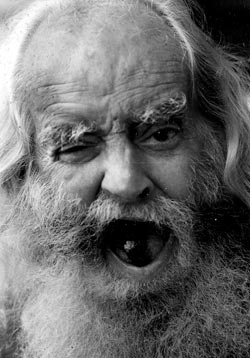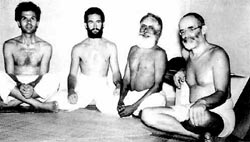
Getting to know a SwamiThis was no everyday ascetic, but one who loved a drink and a cigar says Manik Sandrasagra as he writes to celebrate the 100th birth anniversary of the enigmatic German national Gauribala Swami, who lived in Sri Lanka
Sometime in the eighties I happened to walk into the office of the then Minister of Hindu Religious Affairs P. Devarajah. He was at a meeting with some elderly Hindus and I was asked to be seated. I could not but overhear their conversation which had great relevance to the spiritual lineage I had been initiated into, on my return to Sri Lanka in 1971 after five years in the west. Lay devotees of Yogaswami the Sage of Jaffna, were arranging with Minister Devarajah to commemorate Swami’s birth anniversary with a postage stamp, a statue and a road being named after him. Believing that I had been sent to stop this secular desecration I spoke up. Will a stamp that would be licked, pushed into a postbox, franked at the post office and end up as garbage enhance a Sage’s reputation? Will statues that are of use only for birds to relieve themselves propagate wisdom? Will polluted roads the hallmark of commerce named after Swami increase piety? The minister responded positively to what I said and the lay devotees became silent. The campaign was abandoned and the traditional attitude endeared as if by magic. Yogaswami Siddahs like Yogaswami did not celebrate birthdays, nor did they pose for photographs, write books, or use titles like Reverend, Doctor and Venerable. They did not seek adulation or devotees, nor did they reveal themselves to an ignorant sensation-seeking media. These anonymous free spirits moved at will like the wind. When a Siddha speaks it is often in riddles with multiple meanings but it is always the Eternal Dhamma, and wherever they chose to be, they were attended to by an enlightened community – ariya sangha - from the four quarters of the world. The world itself was their home. This is the sangha or community that for centuries found felicity in a Holy Land called Sri Lanka. It was my good fortune that on returning home in 1971 I found in Sri Lanka an Ariya Sangha from the four quarters of the world still enjoying her felicity. After five years in a material world in North America I never expected to meet an enlightened Siddha roaming around this island roaring like a lion and living the myth in modern times. Peter Schonfeld alias Nyanakhetto Thera alias Gauribala Swami alias German Swami came to Sri Lanka sometime in the 1930’s escaping from a Europe that was witnessing the rise of Hitler. His brother Multi, Paul Zils who contributed greatly to the art of film documentation in this country, and several young Germans in their twenties came at the same time to Ceylon in search of ‘an island of light’ or Dhammadweepa - located somewhere in the mystic east. For them Lanka had the same symbolic value as for the ancients. It was magical and the abode of the wise. This movement east mostly of Germans of Jewish origin is well documented in the book Seven Years in Tibet by Heinrich Harrer. I first met Gauribala Swami in 1971. He was staying with Mike and Elizabeth Wilson on Barnes Place. A bare bodied European dressed in a white un-seamed cotton cloth and being called Swami was being treated with great respect in the household when I was introduced to him. He called me ‘the crown crested gem’ which I did not know was the meaning of my name. From the beginning I noticed that unlike holy men, he made no secret of the fact that he enjoyed a drink and a Jaffna cigar and was living life to the fullest. Happiness and mischief permeated from every pore of his being. This was no ascetic or saint. He was Rabelaisian. I however was shocked, being at that time a brain washed subscriber to Galle Road civilization and its morality. I expected Swamis to be saintly and holy, but for Swami Swa meant being and mi meant self – the word Swami meaning being oneself. On his rare visits to Colombo in the seventies, Swami attracted people from Archaeological Commissioner Raja De Silva to Chitrasena. He danced with them both, dropping tit bits on Sihagiri as he called Sigiriya for Raja’s benefit and striking matching postures with Chitrasena. Raja several years later on the 30th of September 2002 inscribed my copy of his book ‘Sigiriya and its Significance’ with the words “The debt to Swami Gauribala’s wisdom is recorded here”. This man performed no siddhis or miracles on demand as modern Gurus do but played with words and ideas. Stranger than fiction I remember once when Captain Leslie de Silva of Air Ceylon called on me. My house guest Swami Gauribala answered the door. Since I was not in he soon left but called me the very next day to inquire as to who had answered the doorbell. When I told him who it was he told me an amazing tale. He was the pilot of an Air Ceylon plane plying between Jaffna and Colombo. One day a saffron robed European Swami was one of the passengers. Since the flight had been delayed the Swami insisted that he wanted to get down at Katunayake since he was meeting the Canadian High Commissioner James George who was arriving there from abroad in one hour. Leslie laughed and advised Swami to take a taxi from Ratmalana. The flight took off and just when they were approaching Colombo the visibility was so bad that the plane was forced to land at Katunayake. Swami disembarked, thanked Leslie and left. Leslie was left dumbfounded and he had not met this man thereafter. Seeing him at my door several years later rekindled his memory and that evening he came home to enjoy a drink of Chivas Regal with Swami. Another incident concerns Kavichandra Alexander. Kavi is from Batticaloa and is today one of the world’s most respected Recording Engineers cum Producers with his label Waterlily Acoustics having twice won the ‘World Music’ category in the Grammy Awards. Gauribala Swami and Haro Hara Amma ‘misappropriated’ Kavi’s earring in Kataragama Perehera season when Kavi was quite young and returned it after seven days having blessed it. Acoustic sound is Kavi’s specialty and he has recorded most of the great masters from around the world. Kavi attributes his keen sense of hearing to Murugan, God of Kataragama who transmitted this power through Swami and Haro Hara Amma. Kavi whom I have never met in the flesh found me magically on the net because I had in the past written about the very two people who had changed his life. We are now great friends.
Co-incidence, Siddhi, call it what you may, these things happened. When such things happen it is beyond belief. All those who really ‘knew’ Swami now know that fortune smiles in the presence of a Siddha. I bear witness to this with my own life which is the greatest miracle that I know. There were several others who caught some aspects of the spirit of this remarkable man. Maggie Liddchi who had not met Gauribala Swami wrote a remarkably intuitive novel Earthman which is mostly about the relationship a western seeker had with him set in Jaffna and Kataragama. Richard Boyle and I purchased the screen rights of this book in 1974 and hired Sinhala screenwriter Tissa Abeysekera to write an English screenplay long before he was publicly acclaimed as a brilliant bi-lingual author. The film never got made for lack of funds. Phillip K. Crowe who was American Ambassador to Ceylon also writes about his meeting with Swami in Kataragama in Diversions of a Diplomat in Ceylon (1957). “Behind gold rimmed spectacles shone a pair of merry blue eyes”. “I have no money either,” he said, “but money is neither important nor hard to come by.” The fact that one of the island’s poorest men (in the monetary sense) was standing treat for the representative of the world’s richest country, struck us at the same time and we laughed together.” “His basic philosophy is hard to grasp but seems to centre on simply ‘being’. Freed from virtually all of the tensions and neuroses of modern life, he is sure he is leading an existence far more in harmony with God than most of his fellow men”. “Freed from the wheel of things, he seemed a contented man and one to be envied”. The Pada Yatra Swami and I corresponded. I still have the letters he wrote. He never dated letters but rather preferred stating here and now. It was however, sometime in 1975 that he wrote to me trying to entice me to join the annual Pada Yatra or foot pilgrimage, from Jaffna to Kataragama; “The road is open for you, my dear! But time runs out for me. So, here is a new test and trial for you: a very hard one, I tell you: the karai-yatra. If you can do it, even in parts, which means in not too hard a sequence for you, it will be very good for your Guru and Mike, Aiyar and all those who are really sincere in following The Path! I gave you the timetable out of love for you. Now it is up to you, to act! If you come, I must warn you: it will be hard going for you. For me, too. It is my 25th jubilee pilgrimage, and with the help of the Mother’s Grace (Virgin Madre!) and yours, I hope to complete it at Valliamma’s sacred hill. After this my “mission” in Lanka will be completed and I will set out to the ‘Hieric Islands’ for the last “flight of the alone to the Alone”. The Mike referred to was Mike Wilson who became Siva Kalki Swami in later life and Aiyar was Aja Iskander Schmidlin, the Swiss German artist who became Bhikku Sumedha who lived the last decade of his life in a cave near Kandy, both of whom were greatly influenced by Swami. I responded positively to Swami’s letter and as suggested walked the Yatra with him from Pottuvil to Kataragama. Accompanying Swami on this his last Yatra was also the great dancer Chitrasena. From Kataragama we proceeded as said in the letter to Vallimallai the hill beyond Wedasittikanda where Mike and Aiyar were living in a cave. In a symbolic gesture Gauribala Swami disrobed and draped his kavi cloth on me which I kept on for a day or two before returning to my faded jeans. From then on Swami would only wear white. As he had stated in his letter he was free, but I found that I had been bound by the magic of the Pada Yatra, till I helped revive it in 1989 for the Kataragama Devotees Trust that I founded to continue this ancient tradition. I found that a few of my ancestors had also participated in the Yatra in the past which had been abandoned for a few years due to the increasing hostility en route. From two of us in Nainativu or Nagadipa to a few more in Mullaitivu to twelve in Trincomalee to 40 devotees reaching Kataragama, I handed over my obsession of keeping this ancient tradition alive to the American Patrick Harrigan. He had walked with Swami all the way from Jaffna in 1972 and since 1989 has continued with it for over 16 years. This year was the 20th consecutive Pada Yatra since the recommencement of this tradition, and now it happens spontaneously. Please see Part II next week |
|| Front
Page | News | Editorial | Columns | Sports | Plus | Financial
Times | International | Mirror | TV
Times | Funday
Times || |
| |
Copyright
2007 Wijeya
Newspapers Ltd.Colombo. Sri Lanka. |

